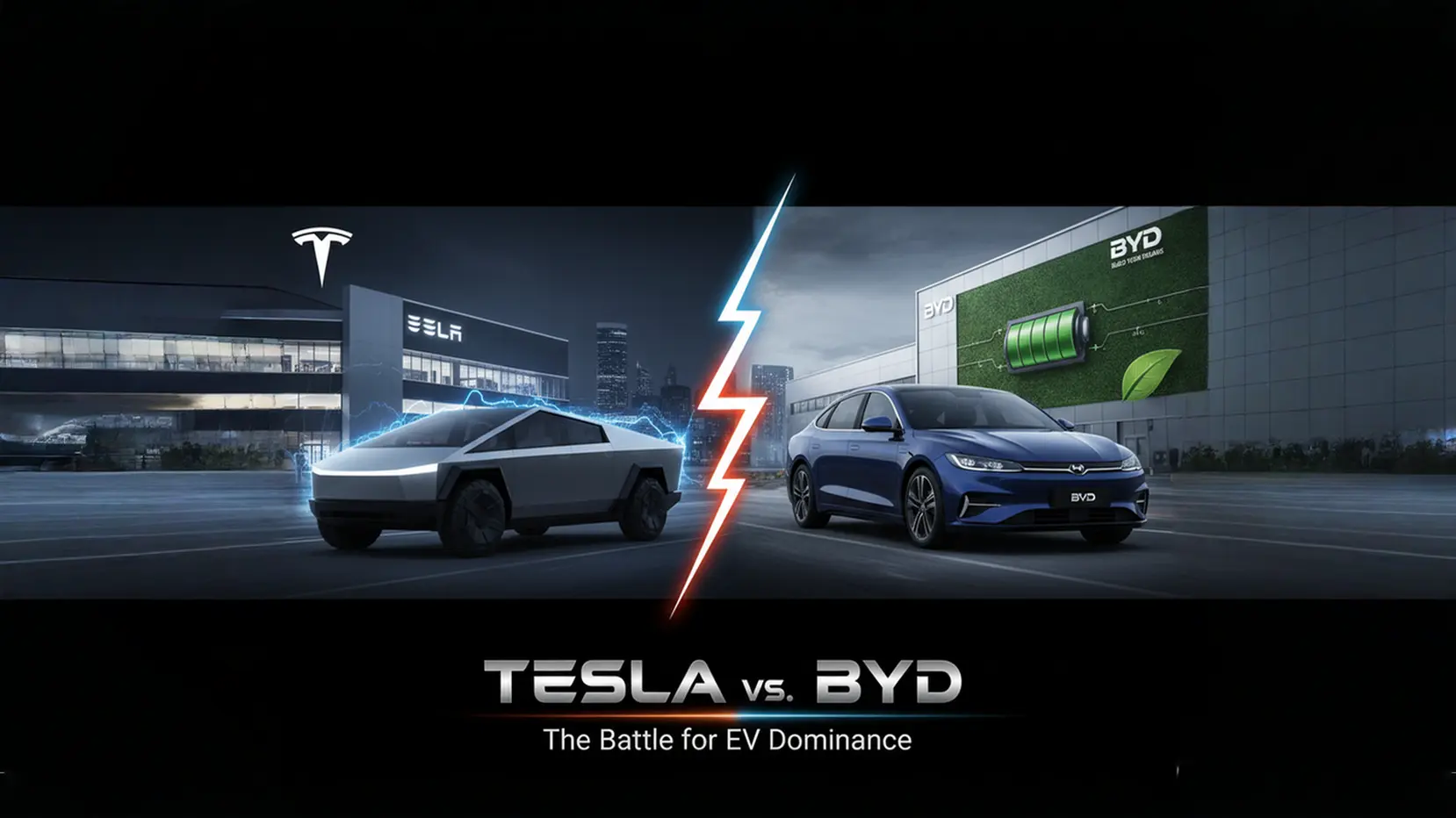Author: Dev Patel | EQMint | General News
October 8, 2025 — The global electric vehicle (EV) war has reached an inflection point. On one side stands Tesla, the American pioneer led by Elon Musk, boasting a staggering market capitalization of $1.2 trillion. On the other is BYD, China’s rapidly expanding EV powerhouse, with a market cap of $130 billion — yet astonishingly higher annual revenue of $107 billion, compared to Tesla’s $97 billion.
This stark contrast between valuation and revenue underscores not only the diverging investor perceptions of both automakers but also the shifting balance of power in the global electric mobility industry.
Tesla: The Trillion-Dollar Trailblazer
Tesla remains the undisputed icon of the EV revolution. Since its founding in 2003, the company has transformed from a niche luxury startup into a mainstream automaker, reshaping how the world perceives electric cars. Its $1.2 trillion valuation places it among the most valuable companies globally — surpassing traditional auto giants like Toyota, Volkswagen, and General Motors combined.
Yet Tesla’s dominance in the market capitalization race reflects future growth expectations, not just current profitability. Investors continue to bet heavily on Tesla’s technological ecosystem — spanning battery innovation, self-driving capabilities, solar energy, and AI-driven automation.
The company’s 2024 revenue stood at around $97 billion, largely driven by strong sales of the Model 3 and Model Y — its most affordable and high-volume vehicles. Despite rising competition, Tesla remains the benchmark for EV design, performance, and technology.
Musk’s relentless focus on vertical integration — from battery manufacturing to software development — has given Tesla a competitive edge in cost efficiency and scale. The company’s Gigafactories across the US, Europe, and China produce millions of vehicles annually, ensuring steady global supply.
However, Tesla now faces a new challenge — saturation in developed markets and intensifying competition from China’s EV juggernauts, led by BYD.
BYD: China’s Electric Titan on the Rise
Founded in 1995 as a battery manufacturer, BYD (Build Your Dreams) has evolved into a global EV and energy storage giant, backed by deep expertise in lithium-ion battery technology. Over the last five years, BYD has emerged as Tesla’s fiercest rival, particularly in China — the world’s largest EV market, accounting for more than half of global EV sales.
BYD’s 2024 revenue surged past $107 billion, overtaking Tesla’s top line for the first time, fueled by record domestic and international demand. The company’s diversified product lineup — from affordable electric sedans to commercial buses and hybrid plug-in models — appeals to a broader demographic.
Unlike Tesla, which sells primarily battery electric vehicles (BEVs), BYD’s strength lies in its dual strategy of BEVs and plug-in hybrids (PHEVs). This approach allows the company to cater to markets where charging infrastructure remains limited — particularly in Southeast Asia, Latin America, and parts of Europe.
With backing from investors like Warren Buffett’s Berkshire Hathaway, BYD has rapidly scaled production capacity, launching new plants in Thailand, Brazil, and Hungary. The company also supplies batteries to other automakers, positioning itself not only as a carmaker but as a critical player in the EV supply chain.
Revenue vs Valuation: A Tale of Two Markets
The comparison between Tesla and BYD highlights a striking disparity: BYD earns more but is valued far less.
Tesla’s $1.2 trillion market cap translates to a price-to-sales (P/S) ratio of over 12, while BYD’s $130 billion valuation corresponds to a P/S ratio of just 1.2. This gap reflects differing investor sentiments in the US and China — and perhaps broader market psychology.
In the US, Tesla’s brand is seen as more than a carmaker; it’s viewed as a technology company, akin to Apple or Nvidia, with growth potential far beyond vehicles. Investors value Tesla for its innovations in autonomous driving, AI chips, and energy storage.
In contrast, Chinese equities often trade at lower valuations due to regulatory uncertainty, geopolitical tensions, and lower investor transparency, even when companies like BYD deliver stronger revenue performance.
BYD vs Tesla: The Battle for Market Leadership
In unit sales, BYD has already overtaken Tesla in global EV deliveries. In 2024, BYD sold 3.2 million electric and hybrid vehicles, compared to Tesla’s 1.8 million all-electric units. However, Tesla remains dominant in the premium EV segment, commanding higher margins and stronger brand loyalty.
BYD’s models like the Seal, Dolphin, and Atto 3 have gained global traction, especially in markets where affordability is key. Meanwhile, Tesla’s recent price cuts across major markets — including the US, China, and India — reflect an attempt to maintain competitiveness against lower-cost rivals.
Both companies are now eyeing India and Southeast Asia as the next major growth frontiers. Tesla has begun talks to set up a manufacturing plant in India, while BYD has already established local assembly partnerships, aiming to capture early mover advantage.
Innovation Race: Software, Batteries, and AI
Tesla’s core strength lies in its software-driven architecture and Full Self-Driving (FSD) technology, which remains years ahead of competitors in terms of data accumulation and AI training. Musk’s vision of turning Tesla cars into “robotaxis” continues to fuel investor optimism about the company’s long-term revenue streams.
BYD, however, leads in battery technology and vertical manufacturing. Its in-house Blade Battery, known for superior safety and efficiency, has been adopted not just in its own vehicles but also by external automakers. BYD’s ability to control both battery and semiconductor production gives it resilience against supply chain disruptions that crippled many rivals during the pandemic.
As Tesla expands its Dojo AI computing infrastructure and BYD strengthens its energy storage business, the race between the two has expanded beyond cars — into energy ecosystems, AI integration, and sustainability infrastructure.
Global Impact and the Road Ahead
Tesla’s dominance in Western markets and BYD’s leadership in Asia underscore a bipolar global EV landscape — one driven by innovation and branding, the other by scale and affordability.
While Tesla continues to command a premium valuation thanks to its visionary outlook, BYD’s rise reflects the shifting center of gravity in the EV world — from Silicon Valley to Shenzhen.
Industry experts predict that the next five years will define who ultimately leads the EV 2.0 era, as competition intensifies not only between Tesla and BYD but also with new entrants like Rivian, Nio, and Hyundai’s Ioniq brand.
“Tesla is the Apple of EVs, while BYD is becoming the Samsung,” remarked a Shanghai-based auto analyst. “Tesla sells aspiration; BYD sells access. Both are winning, but in different worlds.”
Conclusion
The Tesla vs BYD rivalry is no longer just a competition between two automakers — it’s a clash of philosophies, geographies, and technologies.
Tesla embodies Western innovation, brand power, and investor faith in exponential growth. BYD symbolizes China’s industrial strength, manufacturing dominance, and pragmatic engineering.
Together, they represent two sides of the same coin — driving the world toward an all-electric future, where innovation knows no borders.
References
- “Chinese electric vehicle maker BYD reports $107B in annual revenue — beating out rival Tesla”
- “Chinese automakers build significant leads in zero-emission vehicle market research” (BYD exceeding Tesla in BEV sales in 2024)
- “China’s BYD outsells Tesla in Europe for first time, report says”
- “BYD’s outpacing of Tesla has only just begun” — analysis of revenue comparisons
Discalimer: This article is based on information available from public sources. It has not been reported by EQMint journalists. EQMint has compiled and presented the content for informational purposes only and does not guarantee its accuracy or completeness. Readers are advised to verify details independently before relying on them.






